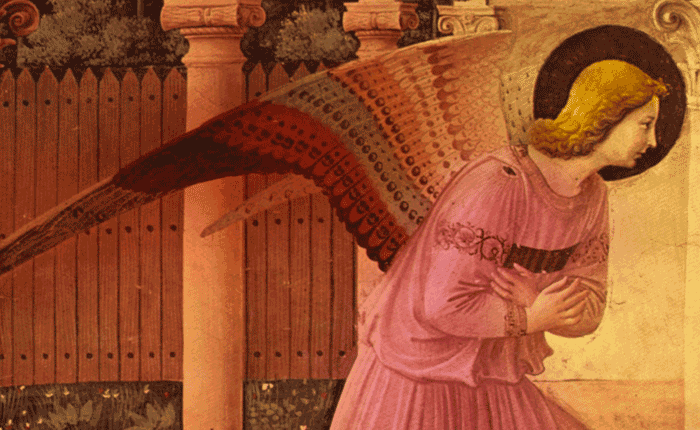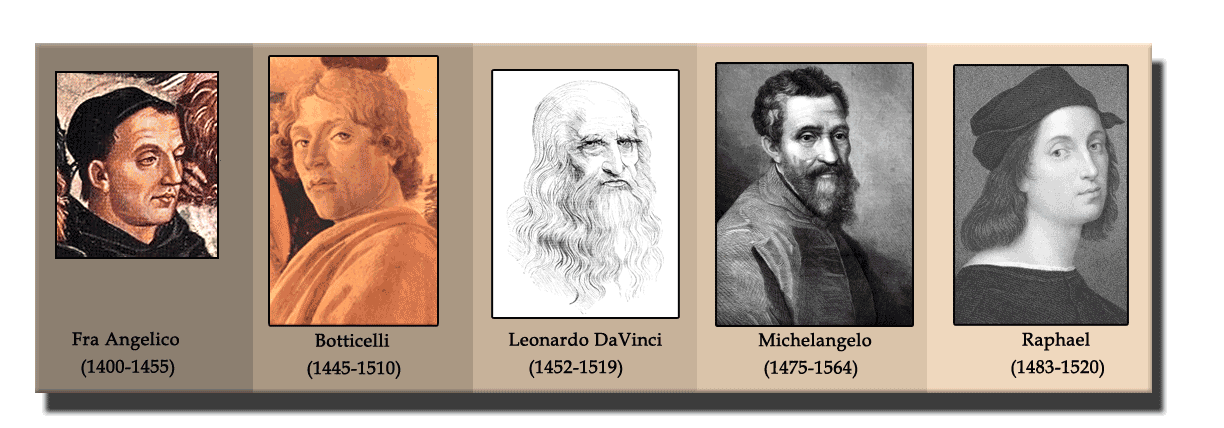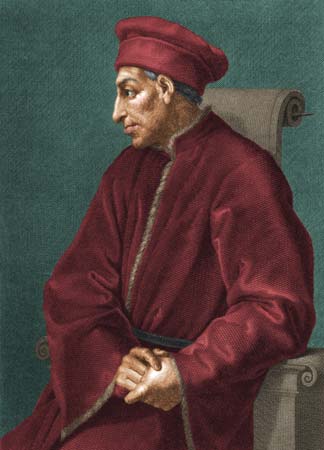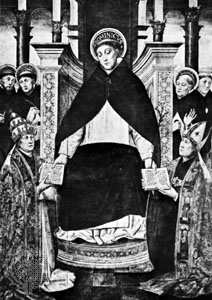
FRA ANGELICO

FRA ANGELICO
Unit Overview
In this unit you will be introduced, briefly, to the five greatest artists of the Italian Renaissance. You will have the opportunity to study each artist in depth throughout this course. This unit is dedicated to Fra Angelico, a fifteenth century Dominican friar and painter known for his religious scenes. The popular image of the angel seen today in most religious works is the angel painted by Fra Angelico. He was very famous in his day. Churches competed for his work!
I. Renaissance Timeline: Major Italian Artists

II. Fra Angelico
When Fra Angelico was born he was named Guido di Piero. He became a Dominican friar when he was twenty, and took the name Fra Giovanni. In Italian, it means "brother john." At his friary, San Marco, he painted many frescos and even had a workshop. After his death he was called Fra Angelico, since both he and his art were so angelic.
Between 1438 and 1452, Fra Angelico made over fifty paintings for the Dominicans in Florence at San Marco. The paintings decorated the friar's individual rooms, their chapel, and the hallways. Angelico believed that an artist had to be someone who lived a quiet life, free from material care. He never took up his brush without saying a prayer first. He painted for simple-minded friars in search of spiritual nourishment. The friary was closed to the public so that the friars could spend their days in quiet prayer.
 Cosimo de' Medici (1382-1464) was the patron of San Marco. This means that he supported the friars with his money, and was responsible for the upkeep of the friary. His money helped build the friary, and install a large library. He even laid out a magnificent garden on the grounds. He is said to have loved San Marco very much, and even kept a cell there so that he could spend time in conversation with the Archbishop and with Fra Angelico.
Cosimo de' Medici (1382-1464) was the patron of San Marco. This means that he supported the friars with his money, and was responsible for the upkeep of the friary. His money helped build the friary, and install a large library. He even laid out a magnificent garden on the grounds. He is said to have loved San Marco very much, and even kept a cell there so that he could spend time in conversation with the Archbishop and with Fra Angelico.
Cosimo belonged to the Medici Clan. The Medici family ruled Florence because of their immense wealth and influence. They were never officially made rulers by law, but they usually got their way. Cosimo
commissioned
altarpieces for San Marco, and his money funded several of Angelico's frescos as well.
Angelico had many assistants at his workshop at San Marco. He would sketch his drawings, called cartoons, and his assistants would transfer his image to the wall before he painted it. Cartoons, for the Renaissance masters, were not comic strips like they are to us today. A cartoon was a detailed drawing made before the artist painted a fresco. Angelico's assistants would "pounce" the cartoon, meaning they pricked the drawing full of holes, and then covered it with charcoal. The charcoal would go through the holes and transfer the design to the wall. This technique is called pouncing.

Modern painters still use similar techniques when transferring a drawing onto the canvas. The artist covers the back of the drawing in charcoal, tapes it to the canvas, and traces the drawing with a blunt object. When he lifts his drawing, the charcoal has a ready-made outline for painting.
Art Project: Let's pounce! Make a photocopy of a drawing you've done. It must be a black-and-white pencil drawing, so that you can imitate the cartoon of a Renaissance artist. Print the project rubric for future use. You never know when you might want to paint a masterpiece! How to Pounce for Painting.

Go to questions 1-6.
III. Religious Painting
Before you take a look at Fra Angelico's works, it is important to understand his subject matter. As mentioned, he was a Dominican friar who lived in a friary. The paintings he did were for a religious, Catholic audience. All of the major Renaissance artists- Botticelli, Leonardo, Michelangelo, and Raphael- painted scenes from the Bible. They also painted great saints and certain religious people at the time, like the pope. Listed below are major saints and key terms you must understand before you look at the works of Fra Angelico.
Saints are people who are very close to God, and they are remembered for their holy works and deeds. The Catholic Church declares certain people saints after they are dead. The pope and other officials investigate their life's work and determine if it was holy.

Roman Catholics believe that certain saints had such a special connection with God, that they were able to perform miracles. They venerate the saints by imitating them, and treating objects associated with them with reverence. Most Protestants do not venerate saints. The Muhammad of Islam declared that there were no saints, but Muslims do honor people that they think are close to God.
One of the most well-known saints is St. Dominic (pictured left). St. Dominic was a priest who spent his life caring for the sick in a hospital. He founded the Dominicans, a religious order of preachers that did good works. He was a very talented scholar, and many Catholic schools are constructed with him and his methods in mind.
Fra Angelico, as said before, joined the Dominican order at San Marco when he was in his twenties. St. Dominic is the subject of most of his paintings at San Marco. No doubt his fellow Dominicans would want to be reminded of St. Dominic wherever they were!

Another well-known saint is St. Francis (pictured left). St. Francis (1182-1226) was the son of a wealthy cloth merchant who gave up all of his wealth and belongings to the poor. Whenever he is painted he is usually barefooted and wearing a brown habit, showing his humility. He had an immense respect for nature because he loved everything created by God. He founded the Franciscans, a religious order that administers help to the poor. St. Francis shows up in many of Fra Angelico's paintings.
Here are some key terms to keep in mind as you view the artwork in this unit:
Martyr: A martyr is someone who died for Christ. The early Christians were not very popular: St. Lawrence was burned alive, St. Sebastian was tied to a post and shot with arrows, St. Peter was crucified upside-down, and Sts. Cosmos and Damien were beheaded. The word "martyr" means "to bear witness". The Christian martyrs bore witness to the teachings of Jesus to the death.
Altarpiece: An altarpiece is a picture of a religious scene suspended behind the altar in a church. Fra Angelico is famous for some of his beautiful altarpieces.
Friary: A friary is a building with several rooms that are used for prayer. A religious community chooses to live there in quiet, shut off from the world. San Marco was the name of Fra Angelico's friary.
IV. Major Works

Go to questions 7-25.
 |
| Unit 3 Cornell Notes Worksheet |